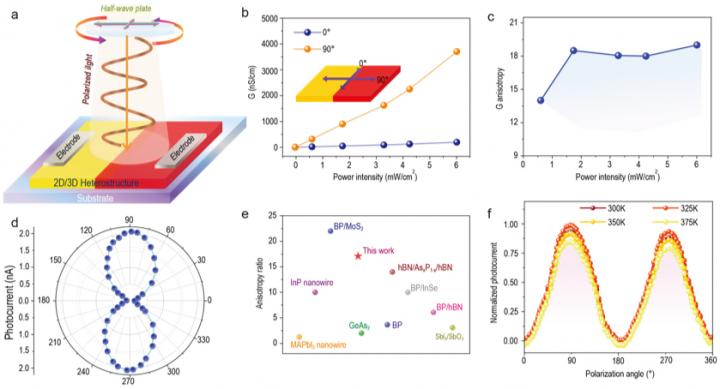
Credit: @Science China Press
Polarization-sensitive photodetectors, based on anisotropic semiconductors, have exhibited wide advantages in specialized applications, such as astronomy, remote sensing, and polarization-division multiplexing. For the active layer of polarization-sensitive photodetectors, recent researches focus on two-dimensional (2D) organic-inorganic hybrid perovskites, where inorganic slabs and organic spacers are alternatively arranged in parallel layered structures. Compared with inorganic 2D materials, importantly, the solution accessibility of hybrid perovskites makes it possible to obtain their large crystals at low cost, offering exciting opportunities to incorporate crystal out-of-plane anisotropy for polarization-sensitive photodetection. However, limited by the absorption anisotropy of the material structure, polarization sensitivity of such a device remains low. Thus, a new strategy to design 2D hybrid perovskites with large anisotropy for polarization-sensitive photodetection is urgently needed.
Heterostructures provide a clue to address this challenge. On the one hand, construction of heterostructures can improve the optical absorption and free-carrier densities of the composite. On the other hand, the built-in electric field at the heterojunction can spatially separate the photogenerated electron-hole pairs, significantly reducing the recombination rate and further enhancing the sensitivity for polarization-sensitive photodetectors. Therefore, constructing single-crystalline heterostructures of anisotropic 2D hybrid perovskites would realize devices with high polarization sensitivity.
In a new research article published in the Beijing-based National Science Review, scientists at the Fujian Institute of Research on the Structure of Matter, Chinese Academy of Sciences create a 2D/3D heterostructure crystal, combining the 2D hybrid perovskite with its 3D counterpart; and achieve polarization-sensitive photodetection with record-high performance. Different from the previous work, devices based on the heterostructure crystal deliberately leverage the anisotropy of 2D perovskite and the built-in electric field of heterostructure, permitting the first demonstration of a perovskite heterostructure-based polarization-sensitive photodetector that operates without the need for external energy supply. Notably, the polarization sensitivity of the device surpasses all of the reported perovskite-based devices; and can be competitive with conventional inorganic heterostructure-based photodetectors. Further studies disclose that the built-in electric field formed at the heterojunction can efficiently separate those photogenerated excitons, reducing their recombination rate and therefore enhancing the performance of the resulting polarization-sensitive photodetector.
“High polarization sensitivity is successfully achieved in self-driven polarization-sensitive photodetector based on a single-crystalline 2D/3D hybrid perovskite heterostructure which is grown via a delicate solution method,” the author claims, “This innovative study broadens the choice of materials that can be used for high-performance polarization-sensitive photodetectors, and correspondingly, the design strategies.”
###
This research received funding from the the National Natural Science Foundation of China, the Key Research Program of Frontier Sciences of the Chinese Academy of Sciences (CAS), the Natural Science Foundation of Fujian Province, the Strategic Priority Research Program of the CAS and the Youth Innovation Promotion of CAS.
See the article:
Xinyuan Zhang, Lina Li, Chengmin Ji, Xitao Liu, Qing Li, Kun Zhang, Yu Peng, Maochun Hong and Junhua Luo
Rational design of high-quality 2D/3D perovskite heterostructure crystals for record-performance polarization-sensitive photodetection
Natl Sci Rev DOI:10.1093/nsr/nwab044
https:/
The National Science Review is the first comprehensive scholarly journal released in English in China that is aimed at linking the country’s rapidly advancing community of scientists with the global frontiers of science and technology. The journal also aims to shine a worldwide spotlight on scientific research advances across China.
Media Contact
Junhua Luo
[email protected]
Original Source
http://doi.
Related Journal Article
http://dx.




